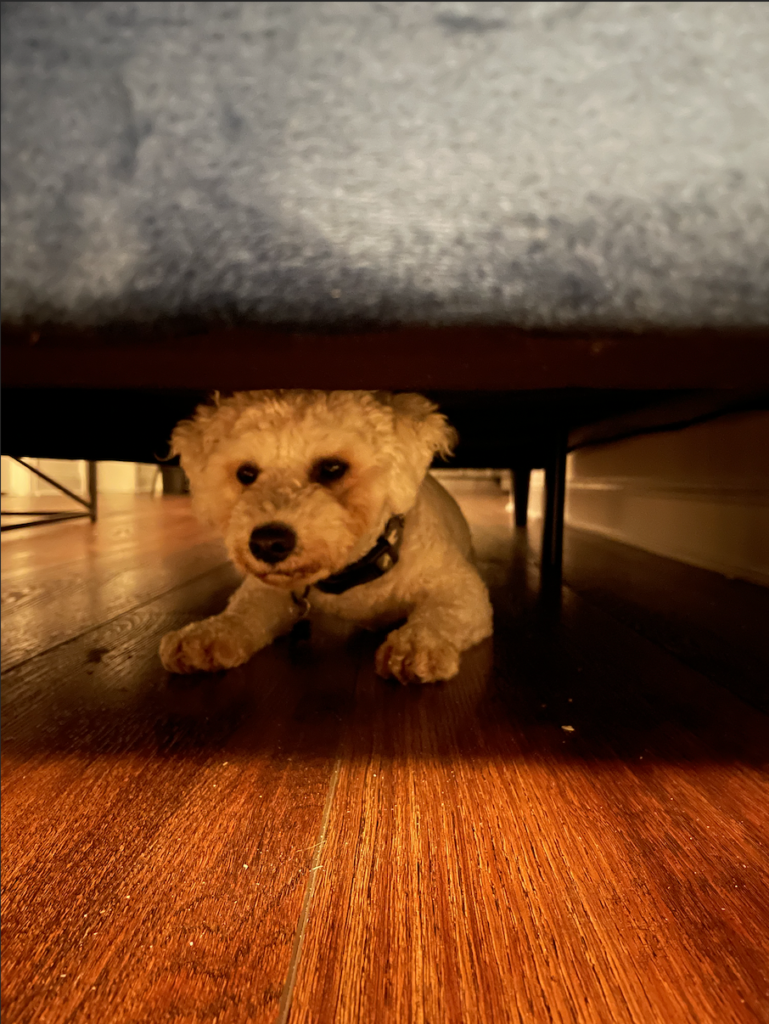Do you have not only a new home, but also some four-legged friends who are coming with you? No problem! While moving into my new place in Phoenixville has definitely been exciting, I was admittedly a bit nervous about the change for Ted, my 1-year-old bichon frise. Pets can easily become stressed during a move, which might cause them to lose their fur, become aggressive, or even run away, there are a few things that you can do to reduce your pet’s anxiety before, during, and after your move. Read on to learn how you can help your pet become well adjustTED (I couldn’t resist the pun!) to his or her new home!
1. Plan Ahead and In Detail
Many people consider their pets a part of the family (Ted certainly is!), so it’s only natural to be concerned for their comfort and safety during a move. Meticulous planning well in advance of moving day is the best way to ensure your pet is as comfortable as possible when moving to a new home. We made sure to have a spot all planned out for his favorite chair and some favorite toys and treats waiting for his arrival!
Make a Checklist of Moving Tasks
As a classic Capricorn, checklists are my jam. But whether you’re a type A or B, throwing these few items on your To Do List can help you move through your move with ease! Don’t forget things like calling your vet or asking someone, (perhaps even your realtor? *wink wink*) for a referral, having your pet microchipped, buying calming medicine or treats (Ted has these for stressful occasions), etc. If you’re planning to transport your pet in a crate or carrier, take time to introduce them to it, especially if your dog or cat hasn’t been in their carrier in a while. Put their food or a few treats in it in the weeks before the move (Ted likes a good peanut butter marrow bone); that way, they’ll be more accustomed to the space and will feel less stressed.
Gather Important Documents
Your new state, county, or community might have different rules for owning a pet, so research what records you will need and what fees you’ll need to pay in order to register them. It might be best to put the following in one organized file just in case:
-
Vaccination records and health certificate
-
Rabies tags (if they’re not already on your pet’s collar)
-
Emergency contact info for your veterinarian
Keep Medication, Food, and Toys Handy
You won’t want to pack up all of your pet’s toys, treats, food, or medications until moving day, so you may want to set aside a box just for your pet for the day of. Be sure to pack this box either in the car with you or within easy reach, just in case of an emergency. We were lucky in that we could have Ted stay with family during our moving day, so while we brought over the majority of his things, we kept his bed, a few favorite toys, a pack of treats, and enough food for the day with him until it was go time.
Update Your Pet’s ID
Ted’s on the tinier side, so his ID tag only fits my cell phone. That said, if you’ve got the space, engrave a new ID tag with your new home address and phone number in case your pet gets lost. Hopefully, this will never happen, but it’s better to be safe than sorry!
2. Keep Pets Comfy + Calm on Moving Day
In the chaos of loading boxes into the moving van, the last thing you want to happen is your pet escaping. Keep your dog or cat in a separate room with their toys, food, and carrier until the time comes to load them into the car. Alternatively, if you have the option available to you, you could let a friend or family member pet sit until it’s time to go like we did with Ted.
Book at a Pet-Friendly Hotel in Advance
If you’re driving a long way or need to stay at a hotel overnight, reserve a pet-friendly hotel room well in advance so you’ll have one less thing to worry about on moving day. From the city to the suburbs, there are plenty of local options if you need one in Philly or along The Main Line!
Take Plenty of Stops on Long Car Rides
While on extended car trips, take frequent stops along the way to give your pet fresh water and food, walk around, and go to the bathroom. A break is also a good idea for yourself, too!
3. Give Pets Time to Adjust to New Surroundings
Pets can become agitated when exposed to new surroundings, so it’s important to keep an eye on them for the first few days after moving. Surround them with their favorite toys and comfort items, like a pet blanket from the old house, to give them a familiar scent to latch on to (or in Ted’s case, a stuffed animal toy, since he loves to chew through any blanket he can get to). Be sure to stick to a routine, too! Take your dog on a walk at the same time and stick to your regular feeding schedule.

Want to learn more about making a move? Contact Giselle to get started!





